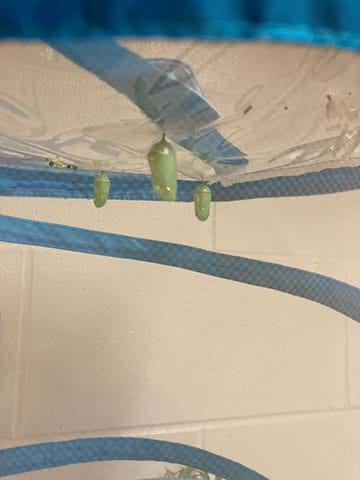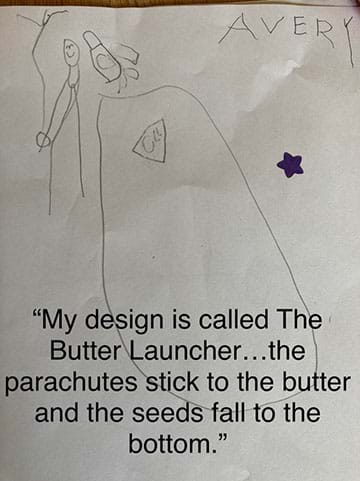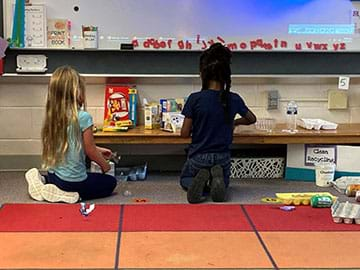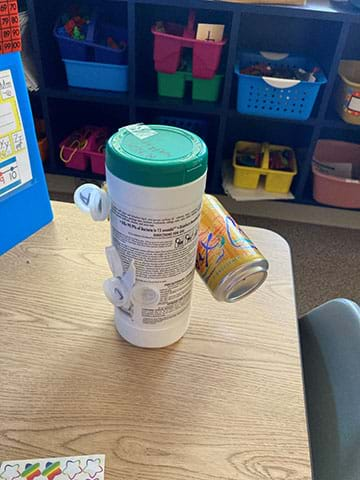Quick Look
Grade Level: 1 (K-2)
Time Required: 2 hours
(eight 15-min periods)
Expendable Cost/Group: US $1.00
Group Size: 3
Activity Dependency: None
Subject Areas: Biology, Life Science
NGSS Performance Expectations:

| K-2-ETS1-1 |
| K-2-ETS1-3 |

Summary
After watching a milkweed seed pod dispersing its seeds and observing how messy and difficult it is to ‘catch’ the seeds, students use recycled materials to create a way to separate the seeds from the parachute. Students then package the seeds for delivery and share them with other classes, along with information on why we need to plant milkweed seeds.Engineering Connection
Industrial engineers work to make things easier and better for factories, computers, and people. They take all sorts of products that we use every day and make them more efficient. Just like industrial engineers, students will find a way to extract seeds from their pods.
Learning Objectives
After this activity, students should be able to:
- Describe the relationship between the monarch butterfly and the milkweed plant as it relates to the food chain, including why the plant is important to the animal.
- Show the life cycle of the milkweed plant including plant parts.
- Apply problem solving strategies to a real-life situation.
Educational Standards
Each TeachEngineering lesson or activity is correlated to one or more K-12 science,
technology, engineering or math (STEM) educational standards.
All 100,000+ K-12 STEM standards covered in TeachEngineering are collected, maintained and packaged by the Achievement Standards Network (ASN),
a project of D2L (www.achievementstandards.org).
In the ASN, standards are hierarchically structured: first by source; e.g., by state; within source by type; e.g., science or mathematics;
within type by subtype, then by grade, etc.
Each TeachEngineering lesson or activity is correlated to one or more K-12 science, technology, engineering or math (STEM) educational standards.
All 100,000+ K-12 STEM standards covered in TeachEngineering are collected, maintained and packaged by the Achievement Standards Network (ASN), a project of D2L (www.achievementstandards.org).
In the ASN, standards are hierarchically structured: first by source; e.g., by state; within source by type; e.g., science or mathematics; within type by subtype, then by grade, etc.
NGSS: Next Generation Science Standards - Science
| NGSS Performance Expectation | ||
|---|---|---|
|
K-2-ETS1-1. Ask questions, make observations, and gather information about a situation people want to change to define a simple problem that can be solved through the development of a new or improved object or tool. (Grades K - 2) Do you agree with this alignment? |
||
| Click to view other curriculum aligned to this Performance Expectation | ||
| This activity focuses on the following Three Dimensional Learning aspects of NGSS: | ||
| Science & Engineering Practices | Disciplinary Core Ideas | Crosscutting Concepts |
| Ask questions based on observations to find more information about the natural and/or designed world(s). Alignment agreement: Define a simple problem that can be solved through the development of a new or improved object or tool.Alignment agreement: | A situation that people want to change or create can be approached as a problem to be solved through engineering. Alignment agreement: Asking questions, making observations, and gathering information are helpful in thinking about problems.Alignment agreement: Before beginning to design a solution, it is important to clearly understand the problem.Alignment agreement: | |
| NGSS Performance Expectation | ||
|---|---|---|
|
K-2-ETS1-3. Analyze data from tests of two objects designed to solve the same problem to compare the strengths and weaknesses of how each performs. (Grades K - 2) Do you agree with this alignment? |
||
| Click to view other curriculum aligned to this Performance Expectation | ||
| This activity focuses on the following Three Dimensional Learning aspects of NGSS: | ||
| Science & Engineering Practices | Disciplinary Core Ideas | Crosscutting Concepts |
| Analyze data from tests of an object or tool to determine if it works as intended. Alignment agreement: | Because there is always more than one possible solution to a problem, it is useful to compare and test designs. Alignment agreement: | |
State Standards
Florida - English
-
Add drawings or other visual displays to descriptions as desired to provide additional detail.
(Grade
K)
More Details
Do you agree with this alignment?
-
Ask and answer questions in order to seek help, get information, or clarify something that is not understood.
(Grade
K)
More Details
Do you agree with this alignment?
-
Participate in collaborative conversations with diverse partners about kindergarten topics and texts with peers and adults in small and larger groups.
- Follow agreed-upon rules for discussions (e.g., listening to others and taking turns speaking about the topics and texts under discussion).
- Continue a conversation through multiple exchanges.
Do you agree with this alignment?
-
Demonstrate command of the conventions of standard English grammar and usage when writing or speaking.
(Grades
K -
12)
More Details
Do you agree with this alignment?
Florida - Math
-
Count to 100 by ones and by tens.
(Grade
K)
More Details
Do you agree with this alignment?
Materials List
Each group needs:
- lab notebook for each student
- writing and drawing supplies (pencils, markers, crayons, etc.)
- other classroom supplies as needed (glue, paper, etc.)
- model of seed pod with seed attached to parachute
- Pre/Post-Quiz, one for each student
- Seed Trap Planning Worksheet, one for each student
- Learning Objective Worksheet, one for each student
- Project Rubrics, one for each group
For the entire class to share:
- The Dandelion Seed by Cris Arbo
- Explore the Life Journey of One of the Winged Wonders of the World by Ann Hobbie
- If You Hold a Seed by Elly MacKay
- various recyclable materials such as old containers (Note: collect in advance of activity)
- sunflower seeds in their shells
- laptop and projector
- seed pods for phenomena/introduction and for final demonstrations, available online from Eden Brothers seed store
For teacher:
- pot
- soil
- seed pods for phenomena/introduction and for final demonstrations, available online from Eden Brothers seed store
- quart jar with lid
Note to teacher: It is possible to order, sprout, and grow milkweed to have milkweed seed pods (it takes about 6 and 8 weeks to grow from seed) or collect seed pods locally. If planting, plant a lot of milkweed as soon as possible. It is easy to grow and maintain. As the plant makes its seed pod, collect them in a glass jar with the lid loosely covering it until it pops open. Then close the jar tight so the seeds won’t fly away.
Worksheets and Attachments
Visit [www.teachengineering.org/activities/view/uof-2637-seed-trap-engineering-design-activity] to print or download.Pre-Req Knowledge
Students should have an understanding of:
- The life cycle and what it entails.
- How seeds grow into plants.
- The needs of a plant (sunlight, water, nutrients, soil).
Introduction/Motivation
Do you know that there is a seed we can eat inside a sunflower shell? [Pass out a handful of sunflower seeds in the shells so each student gets a couple seeds. Give students time to break open the sunflower seed husks.] What kinds of seeds do you know about? (Potential answers: birdseed, apple seeds, chia seeds, pumpkin seeds, pomegranate seeds.) Where do seeds come from? (Answer: From plants.) How can we get the seeds from those plants? (Potential answers: dig them out, crack their shells open.) Are there any tools you could use to make that work easier? (Answer: hammer, fingernail, teeth.) How did you get the sunflower seed open? (Let students share their methods.) Was it easy? Can you think of something that might make it easier to get the sunflower seed out of the shell?
Raise your hand if you have ever seen a dandelion? What does it look like? When dandelions grow, they first develop bright yellow petals before they eventually turn into fluffy globe-shaped seed heads. Have you ever seen its seeds? What happens when you blow on the seeds while it’s still attached to the plant? Why do you think this happens? Each seed on the dandelion has a feathery parachute of soft, white hairs that makes it easily carried by the wind or when you blow on it! Each plant can produce up to 20,000 seeds.
A milkweed seed is a lot like a dandelion. When the pod pops open, all of the seeds have a parachute attached to them. Those parachutes help to spread the individual seeds all around. We need to catch those seeds before they fly away so that we can grow the milkweed plants right where we want them. Engineers are scientists that design and build things that solve a problem or make work easier for people. We are going to be engineers and design and build something that will help us remove the seeds from the parachutes. We will then package and distribute the seeds to the other classes in our school so that they can plant milkweed along with us and help provide a home and food to the monarch butterflies.
Procedure
Background
The milkweed plant is the only plant on which the monarch butterfly lays its eggs. When the egg pops open and a tiny caterpillar comes out, the hungry caterpillar will immediately start eating the leaves and stem of the plant. When the caterpillar has eaten enough and is just the right size, it will change to its pupa stage or chrysalis. After enough time has passed for the animal to change, the chrysalis pops open and a butterfly emerges. When the butterfly is ready, it will begin the process all over again by laying eggs on a milkweed plant. The plant grows new stems and leaves and eventually creates flowers which blossom and make seeds. In this way the plant can begin its life cycle again. The monarch needs the milkweed to lay its eggs on but it also provides food for the caterpillar (larva).
Before the Activity
- Order, sprout, and grow milkweed to have milkweed seed pods (it takes about 6 to 8 weeks to grow from seed) or collect seed pods locally. Growing milkweed seeds could become another activity for students.
- Collect a variety of recycling items, including plastic cups, paper tubes, etc.
- Organize for students to use other materials such as rubber bands, tape, glue, etc.
- Make copies of the Pre/Post-Quiz, Seed Trap Planning Worksheet, Learning Objective Worksheet, Project Rubrics
With the Students
Class #1 (15 minutes):
- Read the Introduction/Motivation section aloud to the class.
- Handout the Pre/Post-Quiz to each student. Tell the kids, “Today we are going to learn about the life cycle of the milkweed plant and its plant parts. I need you to draw a picture of a plant. Show how your plant grows and changes. Color, number and label each part of your plant and its changes.”
- Share out some of the pre-test work samples. Talk about the things that kids draw, wrote and counted and how it is the same or different from the book.
- Read the story The Dandelion Seed by Cris Arbo aloud to the class. (Note: This story shows the life cycle of the dandelion seed which is like the milkweed in the way it disperses its seeds.)
Class #2 (15 minutes)
- Do the motivational activity and/or show students the videos
- Motivation activity option 1: Go outside and look for dandelions. Ask students to collect them and then try to catch the seeds as they float around. Begin a discussion using the following questions: Was it easy to catch the seeds? How many were you able to collect? What made it difficult? How can we make it easier?
- Motivation activity option 2: Stand in a circle outside and blow a dandelion or open a milkweed seed pod. Ask students to try to catch the seeds as they float around. Begin a discussion using the following questions: Was it easy to catch the seeds? How many were you able to collect? What made it difficult? How can we make it easier?
- Show students the video, “Time laps Dandelion flower to seed head” -- https://www.youtube.com/watch?v=UQ_QqtXoyQw. This video visually shows how the flower looks and then what the seeds look like after the flower fades.
- Show students the video, “The secret physics of dandelion seeds” -- https://www.youtube.com/watch?v=N2UbaDV9O9Q. The video visually shows and explains how the dandelion changes.
Class #3 (15 minutes):
- Research: Have students watch the first 2 minutes of the video Milkweed & the Monarch Butterfly Life Cycle -- https://www.youtube.com/watch?v=BhRJlJOK3Vo. The video visually shows the milkweed seed pod opening and dispersing seeds. During the video, discuss how the dandelion and the milkweed seeds are the same and different.
- Research: Read the story Monarch Butterflies: Explore the Life Journey of One of the Winged Wonders of the World by Ann Hobbie aloud to the class. Potential questions to ask: Why is the milkweed so important to the monarch caterpillar? (Answer: Butterflies lay eggs on leaves, caterpillars hatch and eat the leaves.) How are the plant and animal connected? (Answer: They are part of the food chain, one eats the other and one lays eggs on the other.)
- Research: Have each student draw a picture to show the part of the food chain that includes caterpillars and plants on their Learning Objective Worksheet. Make sure to tell students to color, number and label each part.
- Communicate: Gather the class back together and share out some work samples and discuss.
Class #4 (15 minutes)
- Review: Tell the students or allow them to recap what they have learned about butterflies, caterpillars, and milkweed plants.
- Design Challenge: Tell students the challenge of the activity: “Butterflies are an important part of the food chain and excellent pollinators. Although the monarchs feed on the nectar of many flowers, they only lay their eggs on certain species of milkweed plants. Unfortunately, milkweeds have experienced significant plant loss, resulting in a lower monarch population. We can work like botanists (plant scientists) and entomologists (insect scientists) to study why more milkweed might help save the monarchs, but engineers are the ones who build things to solve some of these problems, too. We will be engineers and figure out a way to remove the seeds from their parachutes. We can harvest those seeds and package them to share with other classes without mess.”
- Brainstorm: Individually have students draw and label their design idea for a way to remove the seeds from the parachute on their Seed Trap Planning Worksheet.
- Have students record what materials they need for their design in their Seed Trap Planning Worksheet.
- Collect papers and review student work. Later, sort the work into similar projects to create groups for the next session.

Class #5 (15 minutes)
- Assign students to groups based on their sketched designs from the previous class session.
- Brainstorm: Ask each team member to share their idea with their teammates, recording the names of who they shared with. Allow time for at least each student to share one design but if time students could share multiple ideas.
- Brainstorm: Pull everyone back together and ask if they know why they were grouped with their teammates and/or explain (as needed). Explain: “I put you in groups because your design ideas are similar. Think about what you learned by looking and listening to other peoples’ ideas. Draw or write about changes you would consider making to your iteration.” Give students 5 minutes to allow students to make to notes on their Seed Trap Planning Worksheet.
- Plan: Ask students to draw their updated design in their lab notebook including labels and numbers. Students may consult with their group members as needed.
- Plan: Have students record what materials they need for their design in their Seed Trap Planning Worksheet.
- If time, students may collect their listed materials and begin building their first iteration.
- Use a timer; allow time as needed to complete.
Class #6 (15 minutes)
- Create: Give students time to build their prototype.

Students create their inventions using recycled materials. - Test: After each student completes their prototype, have each group member demonstrate their designs with each other.
- Test: Have each student make notes regarding possible changes after each prototype is demonstrated.
Class #7 (15 minutes)
- Read the story If You Hold a Seed by Elly MacKay. This story is a great connection between seeds and growth mindset. Even the littlest seed never gives up! Discuss how this applies to students in this challenge.
- Take a class poll: “Raise your hand if it’s easier to think and create by yourself? Raise your hand if you prefer to work with other people?” Ask kids to explain their preferences.

An early iteration of a seed trap - Tell students, “Now we’re going to take our individual ideas and work as a team to make a group iteration.
- Plan: Give students time to collaborate and draw out their chosen design.
- Plan: Tell students to choose their materials to create a group prototype based on their group plan.
Class #8 (15 minutes)
- Build: Give groups time to create and test their group prototype.
- Test: Have students record what worked and what didn’t work in their lab notebooks.
- Plan: Give groups time to finalize their prototype by drawing it in their lab notebooks.
- Plan: Have group members collect materials they will need for their final iteration.
- Final Test: Use the final iterations to collect the milkweed seeds and begin packaging to share seeds with other classes.
- Reflection: Ask, “What is hard about working by yourself? What is hard about working with other people?” Discuss observations of student behavior. Remember the story and how seeds never give up!
Vocabulary/Definitions
food chain: A hierarchical series of organisms each dependent on the next as a source of food.
life cycle: The series of changes in the life of an organism (such as plant or animal) including reproduction (making a new plant or animal).
parachute: A cloth canopy which fills with air and allows a person or heavy object attached to it to descend slowly when dropped from an aircraft, or which is released from the rear of an aircraft on landing to act as a brake.
plant: Organisms that use photosynthesis to make their own food. Plants have an important role in the world’s ecosystems. They are important in the food chain, as many organisms eat plants or eat organisms which eat plants. The study of plants is called botany.
pod: Covering around a group of seeds; seed container.
seed: A stage of what becomes a plant; enclosed in a covering called the seed coat, usually with some stored food.
Assessment
Pre-Activity Assessment
Brainstorm: Make a list of different kinds of seeds and how they grow.
Ask the class the following question (by a show of hands): Have you ever seen a ‘wishing flower’? (Also known as a dandelion.)
Discuss: Have you ever tried to catch the parts of the plant that got blown when you made your wish? What happened?
Pre-Quiz: Administer the Seed Trap Pre/Post-Quiz.
Activity Embedded (Formative) Assessment
Worksheet/Share Out: Have students work individually and then in pairs on the Seed Trap Planning Worksheet, giving all students time to finish. Have students share their individual design ideas as a group. They should record their idea sketches in their lab notebooks.
Post-Activity (Summative) Assessment
Problem Solving: Have students explain how their design worked or didn’t work. Describe the changes your group made to the design after testing each design. Have students record changes made for each iteration in their lab notebook. (See Project Rubrics for the teacher.)
Post-Quiz: Administer the Seed Trap Pre/Post-Quiz.
Safety Issues
Always wash hands after touching plants or animals.
Troubleshooting Tips
Plant a lot of milkweed as soon as possible. It is easy to grow and maintain. As the plant makes its seed pod, collect them in a glass jar with the lid loosely covering it until it pops open. Then close the jar tight so the seeds won’t fly away.
Let people know that you are collecting seed pods and recycling for this project. All recycling should be cleaned before sending it to school.
Activity Extensions
Make a seed collection (either whole class or individual projects).
Plant dill to attract the swallowtail butterflies.
Read these books:
- Read the story The Bad Seed by Jory John. Talk about the lesson in the story. We need to be aware of and monitor our feelings and recognize that our choices can influence our experiences and the experiences of others.
- Trees, Leaves, Flowers and Seeds: a Visual Encyclopedia of the Plant Kingdom by DK and Smithsonian
- Right This Very Minute: A Table-to-Farm Book About Food and Farming by Lisl H. Detlefsen and Renee Kurilla
Plant other seeds from foods that kids like to eat.
- The Carrot Seed by Ruth Krauss
- The Very Hungry Caterpillar by Eric Carle
- The Tiny Seed by Eric Carle
Activity Scaling
For younger students, go on a seed hunt looking for seeds in the environment and exploring how seeds travel.
For younger students, include ways to gather things to reinforce the concept of collecting seeds. Students could use scoops and spoons in the sand, throw and catch scarves. This will encourage them to think broadly as well as specifically and add to discussions.
For upper grades, students could include measuring the mass of seeds for more equal distribution.
Older students could design a model of the seed pod to give more opportunity to explore with their iterations.
Subscribe
Get the inside scoop on all things TeachEngineering such as new site features, curriculum updates, video releases, and more by signing up for our newsletter!More Curriculum Like This

Students gain an understanding of the parts of a plant, plant types and how they produce their own food from sunlight through photosynthesis. They learn how plants play an important part in maintaining a balanced environment in which the living organisms of the Earth survive. This lesson is part of ...
References
Detlefsen, Lisl H. Right This Very Minute: A Table-to-Farm Book About Food and Farming. Feeding Minds Press (May 1, 2021)
DK and Smithsonian. Trees, Leaves, Flowers and Seeds: a Visual Encyclopedia of the Plant Kingdom. New York, NY: DK Children; Illustrated edition (September 3, 2019)
Copyright
© 2022 by Regents of the University of Colorado; original © 2022 University of FloridaContributors
Shonna Burchett-BradySupporting Program
Engineering for Biology: Multidisciplinary Research Experiences for Teachers in Elementary Grades (MRET), the College of Engineering, University of FloridaAcknowledgements
This curriculum was based upon work supported by the National Science Foundation under RET grant no. EEC 1711543— Engineering for Biology: Multidisciplinary Research Experiences for Teachers in Elementary Grades (MRET) through the College of Engineering at the University of Florida. Any opinions, findings, and conclusions, or recommendations expressed in this material are those of the authors and do not necessarily reflect the views of the National Science Foundation.
Special thanks to Sarah Furtney for the use of her lab, Kevin Li and Peyton Turinetti for all the hand-holding with the math, Andres Rubiano for the science lessons, Chelsey Simmons and Renee Simmons for writing the grant, and Marlina Romano and Kayla Sutcliffe for all of the administrative support.
Last modified: January 19, 2023







User Comments & Tips